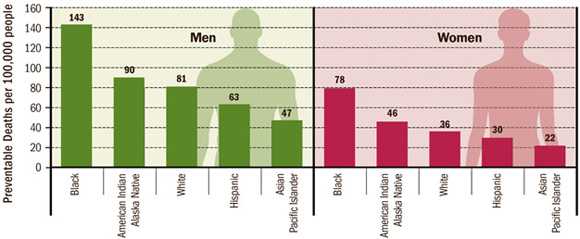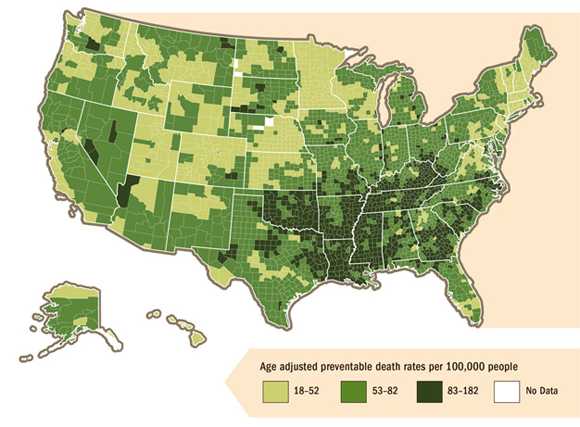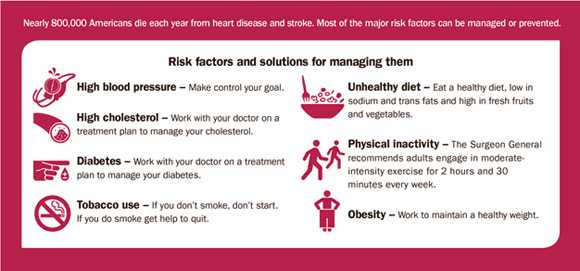Preventable Deaths from Heart Disease & Stroke
Improving care can save more lives
On This Page
September 2013


 200,000
200,000
At least 200,000 deaths from heart disease and stroke each year are preventable.*
 6 in 10
6 in 10
More than half of preventable heart disease and stroke deaths happen to people under age 65.
 2x
2x
Blacks are nearly twice as likely as whites to die from preventable heart disease and stroke.
Nearly 1 in 3 deaths in the US each year is caused by heart disease and stroke. At least 200,000 of these deaths could have been prevented through changes in health habits, such as stopping smoking, more physical activity, and less salt in the diet; community changes to create healthier living spaces, such as safe places to exercise and smoke-free areas; and managing high blood pressure, high cholesterol, and diabetes.
More people will have access to health care coverage and preventive care through the Affordable Care Act. Health care providers should talk with their patients about healthy habits at every visit and follow patients’ progress.
Health care systems and providers can also:
- Use electronic health records to identify and support patients who need help quitting smoking or who have high blood pressure or high cholesterol.
- Refer patients to community resources, such as smoking quitlines and blood pressure selfmanagement programs.
- Track patient progress on the ABCS of heart health—Aspirin when appropriate, Blood pressure control, Cholesterol management, and Smoking cessation.
*Preventable (avoidable) deaths are defined as those from ischemic heart disease, stroke, chronic rheumatic heart disease, and hypertensive disease in people under age 75, although changes in health habits and the health care system can reduce death among all ages.
Problem
Many deaths from heart disease and stroke can be prevented.
What do we know about preventable deaths from heart disease and stroke?
Your chances of dying from heart disease and stroke depend on many things.
Age: While the number of preventable deaths has declined in people ages 65-74, it has remained virtually unchanged in people under 65.
Many deaths from heart disease and stroke can be prevented.

SOURCE: National Vital Statistics System, US Census Bureau, 2001-2010.
View large image and text version.
Race/ethnicity: Blacks are nearly twice as likely as whites to die early from heart disease and stroke.
Sex: Men have the highest risk of death across all races and ethnic groups. Black men are most at risk.
Black men are at highest risk of dying early from heart disease and stroke

SOURCE: National Vital Statistics System, US Census Bureau, 2010.
View large image and text version.
Location: Risk of preventable death from heart disease and stroke varies by county, even within the same state.
Counties in southern states have the greatest risk overall

SOURCE: National Vital Statistics System, US Census Bureau, 2008-2010.
View more maps at the Interactive Atlas for Heart Disease and Stroke.
View large image and text version.
What Can Be Done
Federal government is
- Making it easier for Americans to afford regular preventive health care through the Affordable Care Act.
- Leading the national Million Hearts® initiative to prevent 1 million heart attacks and strokes by 2017.
- Providing resources to all 50 states to address chronic diseases, including heart disease and stroke.
- Leading national campaigns that address risk factors for heart disease and stroke, such as Weight of the Nation® and Tips from Former Smokers.
- Measuring progress in reaching the objectives of Healthy People 2020.
Insurers, health care systems, and providers can
- Use electronic health records to identify and support patients who need help quitting smoking or who have high blood pressure or high cholesterol.
- Use national quality indicators including "controlling high blood pressure" to monitor progress and carry out clinical improvements, such as team-based care.
- Counsel patients to make healthy lifestyle choices. Follow patients’ progress.
- Offer no or lower co-pays on blood pressure and cholesterol medicines.
- Refer patients to community resources, such as smoking quitlines and blood pressure selfmanagement programs.
- Connect uninsured patients with the Health Insurance Marketplace to learn about opportunities for affordable health insurance coverage.
Health departments and community organizations can
- Work with health care systems to monitor national quality indicators, including "controlling high blood pressure," and carry out quality improvements, such as clinical innovations including team-based care.
- Encourage health systems to use health information technology to identify patients who have high blood pressure. Establish follow-up systems to monitor those patients.
- Promote smoking quitlines, tobacco-free areas, safe walking areas, and access to healthy food.
- Partner with hospitals to address health care issues in the community and perform a community health needs assessment to ensure interventions reach those most in need.
Everyone can
- Have a conversation with your health care provider about the ABCS of heart health.
- Get help to stop smoking. If you don’t smoke, don’t start.
- Try going for a brisk 10-minute walk, 3 times a day, 5 days a week.
- Eat a heart-healthy diet with more fruits and vegetables and less sodium and trans fat.
- Know the signs and symptoms of heart attack and stroke, and call 9-1-1 right away if you are experiencing them.
Science Behind the Issue
Related Pages
- Vital Signs Issue details: Avoidable Deaths from Heart Disease, Stroke, and Hypertensive Disease — United States, 2001–2010, Morbidity and Mortality Weekly Report (MMWR)
- Vital Signs – Preventable Deaths from Heart Disease and Stroke [PODCAST – 1:15 minutes]
- Vital Signs – Preventable Deaths from Heart Disease and Stroke [PSA – 0:60 seconds]
- About Heart Disease
- About Stroke
- How Much Physical Activity Do You Need?
- Signs and Symptoms of a Heart Attack
- Interactive Atlas of Heart Disease and Stroke
Recursos en español
- Muertes por enfermedades cardiacas y accidentes cerebrovasculares prevenibles [PODCAST – 1:42 minutos ]
- Million Hearts Initiative
- Cómo controlar la hipertensión [PDF – 1.05 MB]
- Enfermedades cardiacas
- Accidentes cerebrovasculares
- Hoja informativa sobre los accidentes cerebrovasculares
- Temas relacionados
- MedlinePlus en Español Ataque cerebral
- MedlinePlus en Español Enfermedades del corazón
- MedlinePlus en Español Enfermedades del corazón: Prevención
On Other Web Sites
- Healthy People 2020
- MedlinePlus – Heart Diseases
- MedlinePlus – Heart Diseases-Prevention
- MedlinePlus – Stroke
- Reference Card – Blood Pressure [PDF – 60 KB]
- Screening for High Blood Pressure in Adults
- Community Guide: Cardiovascular Disease Prevention and Control
- Quick Reference – Cholesterol
- NIH – Detection, Evaluation and Treatment of High Cholesterol [PDF – 1.02 MB]
- Screening for Lipid Disorders in Adults
- Community Guide: Tobacco Quitline Interventions
- Treating Tobacco Use and Dependence [PDF – 2.04 MB]
- Health Information Exchange
- Regional Extension Center
- Medicare Quality Improvement Organizations
- HRSA, Primary Care Health Center Program
- National Quality Forum – Measures, Reports and Tools
- Page last reviewed: September 3, 2013
- Page last updated: September 3, 2013
- Content source:
- National Center for Chronic Disease Prevention and Health Promotion, Division of Cancer Prevention and Control
- Page maintained by: Office of the Associate Director for Communications (OADC)


 ShareCompartir
ShareCompartir
